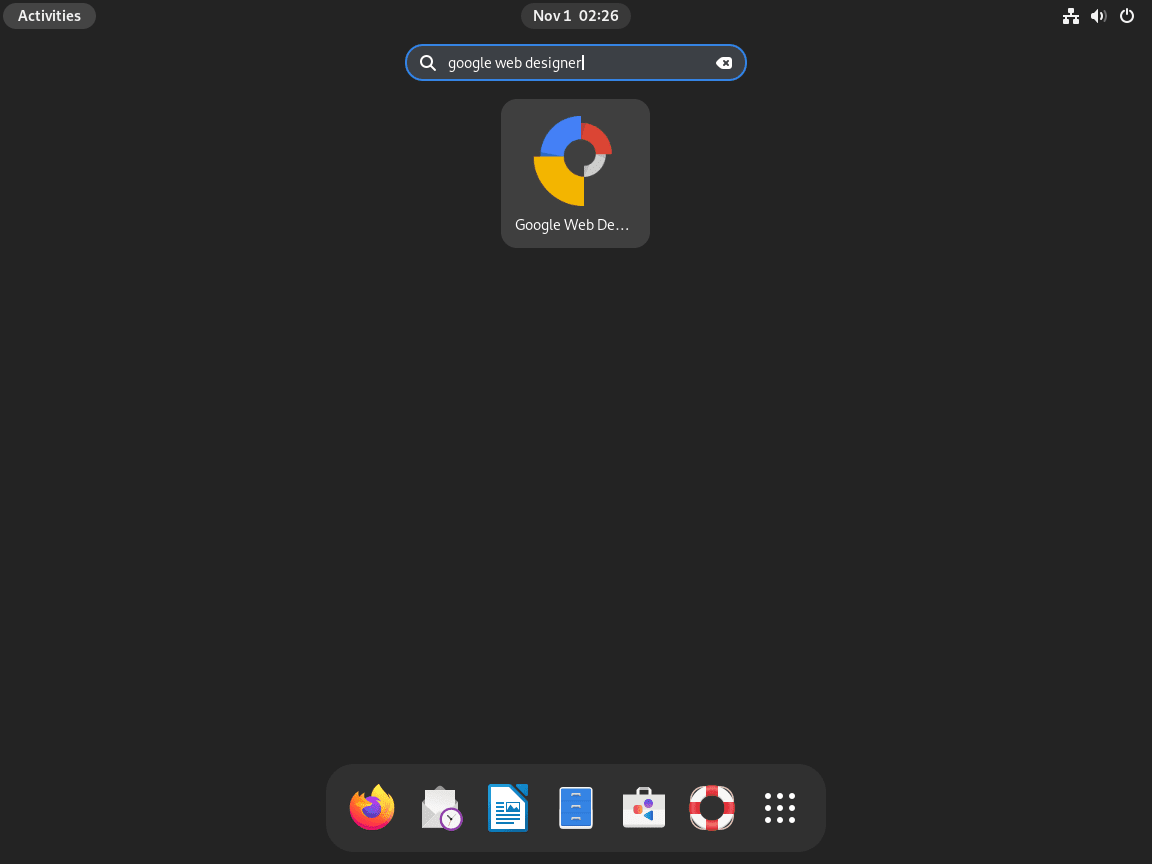Google Web Designer is a powerful and intuitive tool for creating interactive HTML5-based designs and motion graphics. It provides a comprehensive suite of design tools and features, including 3D content creation, animation, and a robust set of components to enhance your web projects. Ideal for designers and developers, Google Web Designer ensures seamless integration with other Google services like Google Chrome and Google Maps Pro.
To install Google Web Designer on Debian 12, 11, or 10 using the command-line terminal, you can utilize the official Google APT repository, which also includes other Google applications. During the setup process, you might encounter multiple sources.list issues. This guide will provide tips on handling these issues to ensure a smooth installation and integration of Google Web Designer and other Google services.
Update Debian Before Google Web Designer Installation
To ensure a smooth installation process, start by updating your Debian system. This step is crucial as it helps to prevent potential conflicts caused by outdated software.
Execute the following command to refresh your package list, ensuring you have the latest information on available updates:
sudo apt updateNext, upgrade all the outdated packages to their latest versions with this command:
sudo apt upgradeDoing this ensures that your system is up-to-date, minimizing the risk of installation issues.
Install Initial Packages for Google Web Designer
Before proceeding with the Google Web Designer installation, you need to ensure that specific essential packages are present on your system. While these packages are typically included in most Linux distributions, it’s always a good practice to verify and install them if necessary.
Run the following command to install the required packages:
sudo apt install curl software-properties-common apt-transport-https ca-certificates -yThis command installs:
curl: A tool for transferring data with URLs.software-properties-common: Provides scripts for managing software repositories.apt-transport-https: Allows the use of ‘https’ in sources.list entries.ca-certificates: Common CA certificates.
If these packages are already installed, the command will not change your system.
Import Google Web Designer GPG & APT Repository
To ensure the authenticity and integrity of the Google Web Designer software, you need to import its GPG key. This cryptographic identifier verifies that the software you are about to install is legitimate and has not been tampered with.
Use the following command to import the GPG key:
curl -fSsL https://dl.google.com/linux/linux_signing_key.pub | gpg --dearmor | sudo tee /usr/share/keyrings/google-web-designer.gpg > /dev/nullWith the GPG key successfully imported, add the Google Web Designer repository to your system. This official source is where you will download the software from. Run the command below to add the repository:
echo "deb [arch=amd64 signed-by=/usr/share/keyrings/google-web-designer.gpg] http://dl.google.com/linux/webdesigner/deb/ stable main" | sudo tee /etc/apt/sources.list.d/google-web-designer.listRefreshing the APT Repository List After Google Web Designer PPA Import
Now that you have successfully added the Google Web Designer repository and ensured all required packages are in place, the next step is to refresh your APT source lists. This action is crucial as it updates the package manager with the latest metadata from the newly added repository, ensuring it knows the Google Web Designer package and its dependencies.
Execute the following command to update the APT source list:
sudo apt updateFinalize Google Web Designer Installation
With your Debian system fully prepared, you are now ready to install Google Web Designer. All necessary dependencies are in place, the repository is configured, and the APT source list is updated.
Run the following command to initiate the installation:
sudo apt install google-webdesignerThis command directs the package manager to retrieve and install the Google Web Designer package from the configured repository.
Starting Google Web Designer
CLI Command to Google Web Designer from the Terminal
For Debian users who prefer the efficiency of the command line, starting Google Web Designer via the terminal is a straightforward task.
Execute the following command to launch Google Web Designer:
google-webdesignerGUI Method Google Web Designer from the Graphical User Interface
Debian’s graphical user interface (GUI) offers a more visual approach for users less accustomed to terminal commands. The GUI simplifies various system tasks, including launching applications like Google Web Designer.
To start Google Web Designer using the GUI, follow these steps:
- Navigate to your screen’s top-left corner and click “Activities.”
- Proceed to click “Show Applications,” typically represented by a grid of dots at the screen’s bottom-left corner.
- In the application list, search for Google Web Designer and select it to initiate the program.



Managing Google Web Designer on Debian: Advanced Commands
Updating Google Web Designer
Google Web Designer constantly evolves, with new updates bringing enhanced features, bug fixes, and security improvements. Keeping the application up-to-date is crucial for a seamless, secure, and feature-rich experience.
Refreshing the Package List
Start by updating your package list to ensure your system knows the latest available packages. Run the following command in your terminal:
sudo apt updateThis command fetches the latest package information from all configured repositories, ensuring your system is ready for the update.
Upgrading Google Web Designer
With your package list updated, proceed to upgrade to Google Web Designer. If you wish to update all packages on your system, use:
sudo apt upgradeHowever, if you prefer to specifically update Google Web Designer without affecting other packages, execute:
sudo apt install --only-upgrade google-webdesignerThis command directs Debian’s package manager to focus solely on Google Web Designer, ensuring a targeted update.
Uninstalling Google Web Designer
There might come a time when you need to uninstall Google Web Designer, whether for troubleshooting purposes or because you’ve decided to use a different tool. Follow these steps to remove Google Web Designer from your Debian system.
Removing the Software
Initiate the uninstallation process with the following command:
sudo apt remove google-webdesignerThis command instructs the system to remove Google Web Designer, freeing up space and resources.
Cleaning Up Residual Files
After uninstalling the software, it’s a good practice to remove any residual files and repositories to keep your system tidy. Execute:
sudo rm /etc/apt/sources.list.d/google-webdesigner.listThis command removes the Google Web Designer repository from your system, ensuring a clean slate.
Resolving Google Web Designer Sources.list Conflicts on Debian
Navigating the complexities of system administration, you might find yourself entangled in conflicts arising from multiple installations of Google Web Designer on Debian. These installations tend to create individual sources and list files, potentially leading to system conflicts. This section meticulously guides you through resolving these conflicts, ensuring a seamless operation of your system.
Pinpointing the Conflict’s Origin
When you install various versions of Google Web Designer, the system generates a unique source.list file for each version, located in the /etc/apt/sources.list.d/ directory. This multiplicity can cause conflicts during system updates, as the apt update command may stumble upon multiple sources.list files for Google Web Designer, leading to operational discrepancies.
Identifying the Conflict
Conflicts become apparent when you follow this guide to install Google Web Designer and then proceed to install additional software versions. These additional installations introduce extra sources into your system, heightening the risk of conflicts.
Navigating Through the Conflict
Eliminating Conflicting Sources
To address this issue, initiate the conflict resolution by removing the extraneous sources from your system. Ensure you execute the following command in your terminal:
sudo rm /etc/apt/sources.list.d/google-webdesigner.listThis command removes the conflicting sources, leaving the original google-web-designer.list intact, as per the instructions in this guide.
Caution: Be vigilant not to remove google-web-designer.list. If you accidentally do so, you can remedy the situation by re-running the GPG import command provided in Section 1 of this guide.
Refreshing the Package List
With the conflicting sources removed, the next step is to update your package list to reflect these changes. Execute the following command:
sudo apt updateThis command ensures your system acknowledges the updated repository configuration, paving the way for a conflict-free environment.
Final Thoughts
Successfully installing Google Web Designer on your Debian 12, 11, or 10 system using the official Google APT repository ensures you have access to the latest features and updates for your web design projects. By following the outlined steps and addressing any sources.list issues, you can maintain a seamless integration with other Google services like Google Chrome and Google Maps Pro.
It’s important to regularly update your repositories and installed packages to benefit from security patches and new functionalities. If you encounter any issues, consult the official documentation or community forums for additional support. With Google Web Designer properly set up, you’re now equipped to create dynamic and engaging web content efficiently.


The following packages have unmet dependencies:
google-webdesigner : Depends: libappindicator1 but it is not installable
E: Unable to correct problems, you have held broken packages.